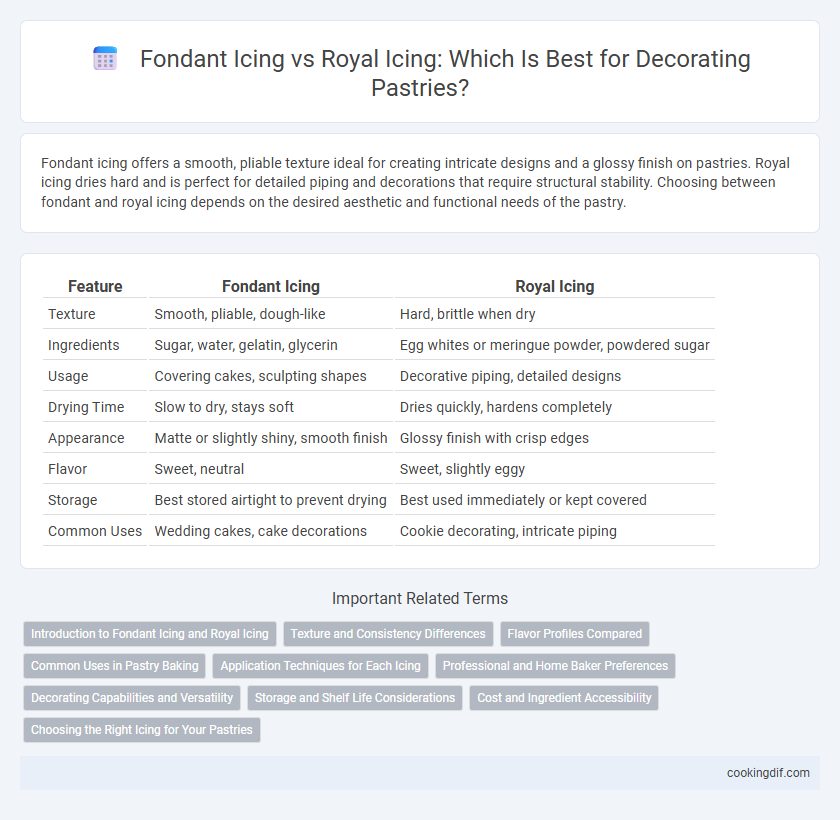Fondant icing offers a smooth, pliable texture ideal for creating intricate designs and a glossy finish on pastries. Royal icing dries hard and is perfect for detailed piping and decorations that require structural stability. Choosing between fondant and royal icing depends on the desired aesthetic and functional needs of the pastry.
Table of Comparison
| Feature | Fondant Icing | Royal Icing |
|---|---|---|
| Texture | Smooth, pliable, dough-like | Hard, brittle when dry |
| Ingredients | Sugar, water, gelatin, glycerin | Egg whites or meringue powder, powdered sugar |
| Usage | Covering cakes, sculpting shapes | Decorative piping, detailed designs |
| Drying Time | Slow to dry, stays soft | Dries quickly, hardens completely |
| Appearance | Matte or slightly shiny, smooth finish | Glossy finish with crisp edges |
| Flavor | Sweet, neutral | Sweet, slightly eggy |
| Storage | Best stored airtight to prevent drying | Best used immediately or kept covered |
| Common Uses | Wedding cakes, cake decorations | Cookie decorating, intricate piping |
Introduction to Fondant Icing and Royal Icing
Fondant icing, a smooth, pliable sugar paste, is widely used for covering cakes and pastries, providing a sleek, polished finish ideal for intricate decorations. Royal icing, made from egg whites and powdered sugar, dries hard to form delicate, detailed designs like piping and lacework on pastries. Both icings offer distinct textures and applications, with fondant favored for its versatility and royal icing prized for its precision and crisp finish.
Texture and Consistency Differences
Fondant icing offers a smooth, pliable texture ideal for achieving a polished, sleek finish on pastries, while royal icing dries hard and brittle, creating a firm and decorative crust. Fondant's consistency allows for easy molding and shaping, making it perfect for intricate designs, whereas royal icing's stiff consistency is best suited for piping detailed patterns and delicate borders. Understanding these texture and consistency differences helps bakers choose the right icing to enhance both the appearance and structural integrity of their pastries.
Flavor Profiles Compared
Fondant icing offers a sweet, creamy texture with a mild vanilla flavor that complements pastries without overwhelming them, often providing a smooth, polished finish. Royal icing has a distinctly sweet, sugary taste with a slightly eggy undertone due to its meringue base, resulting in a crisp texture when dried. Pastry chefs choose fondant for its delicate sweetness and pliability, while royal icing is preferred for intricate decorations requiring a firmer hold and pronounced sugary flavor.
Common Uses in Pastry Baking
Fondant icing is commonly used for creating smooth, sleek surfaces on celebration cakes and pastries, offering a polished finish ideal for elaborate decorations and edible sculpting. Royal icing, favored for its quick-drying properties, is extensively used for intricate piping details, borders, and decorations such as gingerbread house assembly and delicate lace patterns. Both icings serve distinct roles in pastry baking, with fondant providing a canvas for design and royal icing adding fine, structural embellishments.
Application Techniques for Each Icing
Fondant icing offers a smooth, pliable texture perfect for covering cakes and creating sleek, polished finishes, making it ideal for molded decorations and intricate shapes on pastries. Royal icing, made from egg whites and powdered sugar, dries hard and is excellent for detailed piping, delicate lacework, and securing components like gingerbread or layered pastries. Opt for fondant when a seamless, sculpted look is desired, while royal icing excels in fine, decorative designs and structural adhesion.
Professional and Home Baker Preferences
Fondant icing offers a smooth, polished finish favored by professional bakers for wedding cakes and elaborate designs, while home bakers often prefer royal icing for its ease of use and quick drying properties ideal for detailed piping and decorations. Fondant's pliability and moisture resistance make it perfect for sculpted pastries, whereas royal icing hardens to a crisp, providing a sturdy surface suited for gingerbread houses and delicate embellishments. Preferences vary based on skill level, project complexity, and the desired aesthetic outcomes in pastry crafting.
Decorating Capabilities and Versatility
Fondant icing offers a smooth, pliable texture ideal for creating intricate, polished decorations and seamless cake coverings, making it highly versatile for sculpted designs and multiple layers. Royal icing, known for its quick-drying and hardening properties, excels in detailed piping work, fine borders, and delicate embellishments that require precision and structure. Both icings complement different decorating needs: fondant for bold, sculptural versatility, royal icing for crisp, detailed decoration.
Storage and Shelf Life Considerations
Fondant icing offers superior storage longevity, remaining pliable and fresh for several weeks when stored in an airtight container at room temperature. Royal icing, which hardens quickly, has a shorter shelf life and tends to become brittle, making it less ideal for long-term storage beyond a few days. For pastries requiring extended display or storage, fondant icing is preferred due to its durable and moisture-retentive properties.
Cost and Ingredient Accessibility
Fondant icing typically costs more than royal icing due to its specialized ingredients like gelatin and glucose syrup, which can be harder to find in standard grocery stores. Royal icing, made primarily from powdered sugar, egg whites, and lemon juice or water, is more cost-effective and ingredients are widely accessible. For budget-conscious bakers, royal icing offers a practical option without compromising the decorative finish on pastries.
Choosing the Right Icing for Your Pastries
Fondant icing offers a smooth, polished finish ideal for wedding cakes and elaborate designs, providing a sturdy base that holds shape well in warmer conditions. Royal icing, made from egg whites and powdered sugar, dries hard and is perfect for intricate piping, detailed decorations, and creating edible embellishments. Selecting the right icing depends on the desired texture, aesthetic complexity, and the environment in which the pastry will be displayed or served.
Fondant icing vs royal icing for pastries Infographic

 cookingdif.com
cookingdif.com